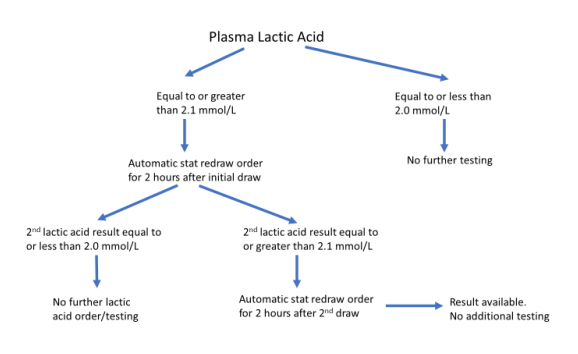Lactic Acid, Plasma
Lactate
Test Codes
EPIC: LAB5133, Beaker: LA
Department
Chemistry
Specimen Collection Criteria
Collect: One Gray-top Fluoride Oxalate tube.
See Minimum Pediatric Specimen Requirements.
See Lactic Acid Reflex Testing flow diagram after Clinical Utility section – this applies to all In-patients and Emergency Center patients. It does not apply to Out-patient orders.
Physician Office/Draw Specimen Preparation
Maintain specimens refrigerated (2-8°C or 36-46°F) prior to transport. Room temperature (20-26°C or 68-78.8°F) is acceptable for a maximum of 8 hours.
Preparation for Courier Transport
Transport: Whole blood, refrigerated (2-8°C or 36-46°F). (Minimum: 0.5 mL)
Rejection Criteria
- Moderate to grossly hemolyzed specimens.
- Specimens not collected in fluoride oxalate tubes.
- Specimens not collected and processed as indicated.
Inpatient Specimen Preparation
Transport to the STAT Laboratory (Royal Oak) or to the Chemistry Laboratories, immediately after collection.
In-Lab Processing
Separate plasma from cells immediately after obtaining blood sample.
Storage
Specimen Stability for Testing:
Plasma After Centrifugation in Fluoride Oxalate (Gray-top tubes)
Room Temperature (20-26°C or 68-78.8°F): 8 hours
Refrigerated (2-8°C or 36-46°F): 7 days
Frozen (-20°C/-4°F or below): Unacceptable
Uncentrifuged Whole Blood in Fluoride Oxalate (Gray-top tubes)
Room Temperature (20-26°C or 68-78.8°F): 8 hours
Refrigerated (2-8°C or 36-46°F): 7 days
Frozen (-20°C/-4°F or below): 30 days (aliquot separated from cells)
Specimen Storage in Department Prior to Disposal:
Refrigerated (2-8°C or 36-46°F): 7 days (Whole Blood)
Laboratory
Dearborn Chemistry Laboratory
Farmington Hills Chemistry Laboratory
Grosse Pointe Chemistry Laboratory
Lenox Chemistry Laboratory
Livonia Chemistry Laboratory
Royal Oak STAT Laboratory
Taylor Chemistry Laboratory
Trenton Chemistry Laboratory
Troy Chemistry Laboratory
Wayne Main Laboratory
Performed
Sunday – Saturday, 24 hours a day.
STAT results available within 1 hour of receipt in the Laboratory.
Routine results available within 4 hours.
Reference Range
≤2.0 mmol/L.
Test Methodology
Enzymatic.
Interpretation
Lactate is an end-product of glycolysis arising mainly in muscle, brain and RBC's. Increased levels may reflect increased rates of production and /or decreased clearance rates (by liver and kidney). Increased lactate production occurs during episodes of tissue hypoxia and anaerobic metabolism. Blood cells rapidly metabolize glucose to lactic acid- it is therefore essential to minimize glycolysis of the blood sample (see Specimen Collection Criteria).
Clinical Utility
This assay aids in the evaluation of metabolic acidosis, regional or diffuse tissue hypoperfusion, hypoxia, shock, congestive heart failure, dehydration, complicated postoperative state, ketoacidosis or nonketotic acidosis in diabetes mellitus, patients with infections, inflammatory states, certain myopathies, acute leukemia and other neoplasia, enzyme defects, glycogen storage disease (type1), thiamine deficiency and hepatic failure.
Lactic acid reflex testing for all In-patients and Emergency Center patients:

CPT Codes
83605
Contacts
Chemistry Laboratory – DBN
313-436-2196
Name: Chemistry Laboratory – DBN
Location:
Phone: 313-436-2196
Chemistry Laboratory – FH
947-521-5252
Name: Chemistry Laboratory – FH
Location:
Phone: 947-521-5252
Chemistry Laboratory – GP
313-473-1807
Name: Chemistry Laboratory – GP
Location:
Phone: 313-473-1807
Lenox Laboratory – LNX
947-523-4070
Name: Lenox Laboratory – LNX
Location:
Phone: 947-523-4070
Livonia Laboratory – LVA
947-523-4370
Name: Livonia Laboratory – LVA
Location:
Phone: 947-523-4370
STAT Laboratory – RO
248-898-0325
Name: STAT Laboratory – RO
Location:
Phone: 248-898-0325
Chemistry Laboratory – TYL
313-295-5360
Name: Chemistry Laboratory – TYL
Location:
Phone: 313-295-5360
Chemistry Laboratory – TRN
734-671-3165
Name: Chemistry Laboratory – TRN
Location:
Phone: 734-671-3165
Chemistry Laboratory – TR
248-964-8070
Name: Chemistry Laboratory – TR
Location:
Phone: 248-964-8070
Wayne Main Laboratory
734-467-4274
Name: Wayne Main Laboratory
Location:
Phone: 734-467-4274
Last Updated
4/9/2024
Microtainer® and Vacutainer® are registered trademarks of Becton, Dickinson and Company.
UroVysion® is a registered trademark of Abbott Laboratories. ThinPrep® is a registered trademark of Hologic, Incorporated.